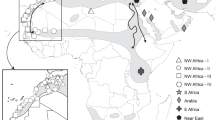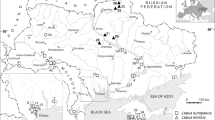Abstract
Despite the well-known fact that evolutionary patterns of single genes or sequences are not necessarily paralleled by organismic evolution, using mitochondrial sequence divergence for inferring phylogenetic relationships among hare species is not uncommon. Earlier studies reported interspecific introgression in the genus Lepus that may slur systematic conclusions drawn exclusively from mtDNA data. We examined pairwise divergence in partial mtHV-1 sequences and nuclear gene pools based on microsatellite and allozyme loci separately in a South and North African population of cape hares, Lepus capensis, and did not find significant correspondence on the individual level within either population. Also, the former population had a significantly higher level of mtHV-1 sequence divergence compared to the latter, but levels of individual nuclear gene pool divergence did not differ significantly between the two populations. Hence, the absence of correspondence between mtHV-1 sequence divergence and nuclear gene pool divergence among individuals within a population might be independent of the population-specific level of differentiation among individuals. Our results complement earlier findings in hares, and strongly recommend to include nuclear gene pool evidence for systematic inferences within this genus, even under the absence of mitochondrial introgression.
Zusammenfassung
Ungeachtet der schon lange bestehenden Kenntnis, dass Divergenzen mitochondrialer (mt) Sequenzen (HV-1) nicht notwendigerweise mit entsprechenden Divergenzen im Kerngenom einhergehen, wurden in jüngster Zeit immer wieder ausschließlich mtDNA-Daten für die Rekonstruktion stammesgeschichtlicher Zusammenhänge im Genus Lepus herangezogen. Dabei kann insbesondere interspezifische Introgression der mtDNA im Genus Lepus zu irreführenden phylogenetischen Schlussfolgerungen führen. Gegenwärtig zeigen wir am Beispiel zweier Kaphasenpopulationen aus Nord- und Südafrika, dass innerhalb jeder Population die individuellen mtDNA-Sequenzunterschiede nicht den jeweiligen Kerngenom-Unterschieden entsprechen. Letztere wurden anhand von sieben Enzymloci und elf Mikrosatellitenloci ermittelt. Ausserdem zeigte die südafrikanische Population ein signifikant höheres Niveau an individuellen mtDNA-Sequenzunterschieden gegenüber der nordafrikanischen Population; ein entsprechender Unterschied im Kerngenom ließ sich allerdings nicht erkennen. Auf molekularer Ebene müssen im Genus Lepus für phylogenetische Schlussfolgerungen unbedingt Kerngenomdaten mitberücksichtigt werden; auch dann, wenn interspezifische Introgression keine Rolle spielt.
Similar content being viewed by others
References
Alves, P.C., Branco, M., Matias, O., Ferrand, N., 2000. New genetic variation in the European hares, Lepus granatensis and L. europaeus. Biochem. Genet. 38, 87–96.
Alves, P.C., Ferrand, N., Suchentrunk, F., Harris, DJ., 2003. Ancient introgression of Lepus timidus mtDNA into L. granatensis and L. europaeus in the Iberian peninsula. Mol. Phylogenet. Evol. 27, 70–80.
Alves, P.C., Harris, D.I., Melo- Ferreira, I., Branco, M., Suchentrunk, F., Boursot, P., Ferrand, N., 2006. Hares on thin ice: introgression of mitochondrial DNA in hares and its implications for recent phylogenetic analyses. Mol. Phylogenet. Evol. 40, 640–641.
Andersson, A.-C, Thulin, C.-G., Tegelström, H., 1999. Applicability of rabbit microsatellite primers for studies of hybridization between an introduced and native hare species. Hereditas 130, 309–315.
Avise, I.C., 1989. Gene trees and organismals histories: a phylogenetic approach to population biology. Evolution 43, 1192–1208.
Avise, I.C., 1994. Molecular Markers, Natural History and Evolution. Chapman & Hall, New York.
Belkhir, K., 2004. GENETIX v. 4.03., logiciel sous Win-dowsTM pour la génétique des populations. Laboratoire Génome, Populations, interactions CNRS UMR 5000, Université de Montpellier II, Montpellier, France.
Belkhir, K., Castric, V., Bonhomme, F., 2002. IDENTIX, a software to test for relatedness in a population using permutation methods. Mol. Ecol. Notes 2, 611–614.
Ben Slimen, H., Suchentrunk, F., Memmi, A., Ben Ammar, Elgaaeid, A., 2005. Biochemical genetic relationships among Tunisian hares (Lepus sp.), South African cape hares (L. capensis), and European brown hares (L europaeus). Biochem. Genet. 43, 577–596.
Ben Slimen, H., Suchentrunk, F., Memmi, A., Sert, H., Kryger, U., Alves, P.C., 2006. Evolutionary relationships among hares from North Africa (Lepus sp.), South African cape hares (L capensis), and European brown hares (L. europaeus), as inferred from mtDNA PCR-RFLP and allozyme data. I. Zool. Syst. Evol. Res. 44, 88–99.
Ben Slimen, H., Suchentrunk, F., Shahin, A.A.B., Ben Ammar Elgaaied, A., in press-a. Phylogenetic analysis of mtCR-1 sequences of Tunisian and Egyptian hares (Lepus sp. or spp., Lagomorpha) with different coat colours. Mamm. Biol.
Ben Slimen, H., Suchentrunk, F., Stamatis, C., Sert, H., Shahin, A.A.B., Alves, P., Mamuris, Z., Ben Ammar Elgaaied, A., in press-b. Microsatellite variation within and among brown hares (Lepus europaeus) and African cape hares (L. capensis): a population genetic approach to test the hypothesis of conspecificity. Biochem. Syst. Ecol.
Bonhomme, F., Fernandez, I., Palacios, F., Catalan, I., Machordon, A., 1986. Charactérisation biochimique du complex d’espèces du genre Lepus en Espagne. Mammalia 50, 495–506.
Cavalli-Sforza, L.L., Edwards, A.W., 1967. Phylogenetic analysis: models and estimation procedures. Am. I. Hum. Genet. 19, 233–257.
Estonba, A., Solís, A., Iriondo, M., Sanz-Martín, M.I., Pérez-Suàrez, G., Markov, G., Palacios, F., 2006. The genetic distinctiveness of the three Iberian hare species: Lepus europaeus, L. granatensis, and L. castroviejoi. Mamm. Biol. 71, 52–59.
Excoffier, L., Laval, G., Schneider, S., 2005. Arlequin ver. 3.01: an integrated software package for population genetics data analysis. Evol. Bioinform. Online 1, 47–50.
Felsenstein, I., 2004. PHYLIP (Phylogeny Inference Package), Version 3.6b. University of Washington, Seattle.
Flux, I.E.C., Angermann, R., 1990. Hares ab Jackrabbits. In: Chapman, I.A., Flux, J.E.C. (Eds.), Gland, Rabbits, Hares and Pikas. Status Survey and Conservation Action Plan. IUCN/SSC Lagomorph Specialist Group, Flux, pp. 61–94.
Fu, Y.-X., Li, W.-H., 1993. Statistical tests of neutrality of mutations. Genetics 133, 693–709.
Halanych, K.M., Demboski, I.R., van Vuuren, B.I., Klein, D.R., Cook, I.A., 1999. Cytochrome b phylogeny of North American hares and jackrabbits (Lepus, Lagomorpha) and the effects of saturation in outgroups taxa. Mol. Phylogenet. Evol. 11, 213–221.
Hebert, P.D.N., Stoeckle, M.Y., Zemlak, T.S., Francis, C.M., 2004. Identification of birds through DNA barcodes. PLoS Biol. 2, 1529–1531.
Hoffmann, R.S., Smith, A.T., 2005. Order Lagomorpha. In: third Wilson, D.E., Reeder, D.A.M. (Eds.), Mammal Species of the World, vol. 1. I. Hopkins University Press, Baltimore, pp. 185–211.
Kasapidis, P., Suchentrunk, F., Magoulas, A., Kotoulas, G., 2005. The shaping of mitochondrial DNA phylogeographic patterns of the brown hare (Lepus europaeus) under the combined influence of Late Pleistocene climatic fluctuac-tions and antrhopogenic translocations. Mol. Phylogenet. Evol. 34, 55–66.
Kumar, S., Tamura, K., Nei, M., 2004. MEGA3: integrated software for molecular evolutionary genetics analysis and sequence alignment. Brief. Bioinf. 5, 150–163.
Kryger, U., 2002. Genetic variation among South African hares (Lepus spec.) as inferrred from mitochondrial DNA and microsatellites. Ph.D. Dissertation, Faculty of Natural and Agricultural Science, University of Pretoria, R.S.A.
Kryger, U., Robinson, T.J., Bloomer, P., 2002. Isolation and characterization of six polymorphic micro satellite loci in South African hares (Lepus saxatilis F. Cuvier, 1823 and Lepus capensis Linnaeus, 1758). Mol. Ecol. Notes 2, 422–424.
Kryger, U., Robinson, T.J., Bloomer, P., 2004. Population structure and history of southern African scrub hares, Lepus saxatilis. J. Zool. (London) 263, 121–133.
Matthee, C.A., Jansen van Vuuren, B., Bell, D., Robinson, T.J., 2004. A molecular supermatrix of the rabbits and hares (Leporidae) allows for the identification of five intercontinental exchanges during the Miocene. Syst. Biol. 53, 433–447.
Mantel, N., 1967. The detection of disease clustering and generalized regression approach. Cancer Res. 27, 209–220.
Melo-Ferreira, J., Boursot, P., Suchentrunk, F., Ferrand, N, Alves, P.C., 2005. Extensive introgression of mountain hare mitochondrial DNA into three Lepus species in Northern Iberia. Mol. Ecol. 14, 2459–2464.
Moritz, C., Cicero, C., 2004. DNA barcoding: promise and pitfalls. PloS Biol. 2, 1529–1531.
Nei, M., 1978. Estimation of average heterozygosity and genetic distance from a small number of individuals. Genetics 89, 583–590.
Pérez-Suárez, G., Palacios, F., Boursot, P., 1994. Speciation and paraphyly in western mediterranean hares (Lepus castrovejoi, L. europaeus, L. granatensis, and L. capensis) revealed by mitochondrial DNA phylogeny. Biochem. Genet. 32, 423–436.
Petter, F., 1959. Eléments d’une révision des lièvres africains du sous-genre Lepus. Mammalia 23, 41–67.
Pierpaoli, M., Riga, F., Trocchi, V., Randi, E., 1999. Species distinction and evolutionary relationships of the Italian hare (Lepus corsicanus) as described by mitochondrial DNA sequencing. Mol. Ecol. 8, 1805–1817.
Queller, D.C., Goodnight, K.F., 1989. Estimating relatedness using genetic markers. Evolution 43, 258–275.
Raymond, M., Rousset, F., 1995. Genepop (version 1.2): population genetics software for exact tests and ecumenism. J. Hered. 86, 248–249.
Robinson, T.J., 1986. Incisor morphology as an aid in the systematics of the South African Leporidae (Mammalia: Lagomorpha). S. Afr. J. Zool. 21, 297–302.
Robinson, T.J., Matthee, C.A., 2005. Phylogeny and evolutionary origins of the Leporidae: a review of cytogenetics, molecular analyses and a supermatrix analysis. Mammal Rev. 35, 231–247.
Rozas, J., Sánchez-DelBarrio, J.C., Messeguer, X., Rozas, R., 2003. DnaSP, DNA polymorphism analyses by the coalescent and other methods. Bioinformatics 19, 2496–2497.
Suchentrunk, F., Polster, K., Giacometti, M., Ratti, P., Thulin, C.-G., Ruhlé, C., Vasil’ev, A.G., Slotta-Bachmayr, L., 1999. Spatial partitioning of allozyme variability in European mountain hares (Lepus timidus): gene pool divergence across a disjunct distributional range? Z. Säugetierk. 64, 1–11.
Surridge, A.K., Bell, D.J., Rico, C., Hewitt, G.M., 1997. Polymorphic microsatellite loci in the European rabbit (Oryctolagus cuniculus) are also amplified in other lago-morph species. Anim. Genet. 28, 302–305.
Tajima, F., 1993. Measurement of DNA polymorphism. In: Takahata, N., Clark, A.G. (Eds.), Mechanisms of Molecular Evolution. Sinauer Associates. Inc., Sunderland, MA, pp. 37–59.
Tamura, K., Nei, M., 1993. Estimation of the number of nucleotide substitutions in the control region of mitochondrial DNA in humans and chimpanzees. Mol. Biol. Evol. 10, 512–526.
Thompson, J.D., Gibson, T.J., Plewniak, F., Jeanmougin, F., Higgins, D.G, 1997. The Clustal X windows interface: flexible strategies for multiple sequence alignment aided by quality analysis tools. Nucl. Acids Res. 24, 4876–4882.
Thulin, C.-G., Jaarola, M., Tegelström, H., 1997a. The occurrence of mountain hare mitochondrial DNA in wild brown hares. Mol. Ecol. 6, 463–467.
Thulin, C.-G., Isaksson, M., Tegelström, H., 1997b. The origin of Scandinavian mountain hares (Lepus timidus). Gibier Faune Sauv. 14, 463–475.
Thulin, C.G., Stone, J., Tegelstrom, H., Walker, C.W., 2006a. Species assignment and hybrid identification among Scandinavian hares Lepus europaeus and L. timidus. Wildl. Biol. 12, 29–38.
Thulin, C.-G, Fang, M., Averianov, A.O., 2006b. Introgression from Lepus europaeus to L. timidus in Russia revealed by mitochondrial single nucleotide polymorphisms and nuclear microsatellites. Hereditas 143, 68–76.
Waltari, E., Cook, J.A., 2005. Hares on ice: phylogeography and historical demographics of Lepus articus, L. othus and L. timidus (Mammalia: Lagomorpha). Mol. Ecol. 14, 3005–3016.
Wu, C., Wu, J., Bunch, T.D., Li, Q., Wang, Y., Zhang, Y., 2005. Molecular phylogenetics and biogeography of Lepus in Eastern Asia based on mitochondrial DNA sequences. Mol. Phylogenet. Evol. 37, 45–61.
Author information
Authors and Affiliations
Corresponding author
Rights and permissions
About this article
Cite this article
Ben Slimen, H., Suchentrunk, F. & Ben Ammar Elgaaied, A. On shortcomings of using mtDNA sequence divergence for the systematics of hares (genus Lepus): An example from cape hares. Mamm Biol 73, 25–32 (2008). https://doi.org/10.1016/j.mambio.2007.02.003
Received:
Accepted:
Published:
Issue Date:
DOI: https://doi.org/10.1016/j.mambio.2007.02.003




